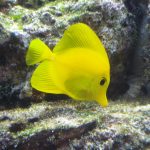Biological and Environmental Sciences
Evolution and Marine Biology
Research
Evolutionary genomics and population biology
Faculty: Gomez-Chiarri, Jenkins, Kolbe, Lane, Puritz, Prada, Schwartz, Putnam, Zhang

Research in this area addresses questions around genetic variation, including how that variation arises and its evolutionary and ecological effects. Cutting-edge genomic laboratory and computational methods are combined with extensive fieldwork.
Current projects include:
- Genomic analysis of nutrient cycling in marine microbial communities
- Population and quantitative genetics of Anolis lizards
- Endosymbiosis of plastids
- Genetics and genomics of lepidoptera
- Diversity and bacterial symbionts of marine ciliates
- Genomic and epigenetic mechanisms of resistance to diseases and environmental stress in marine invertebrates
- Ecology and evolution of coral-algal symbiosis
- Understanding adaptation to multiple anthropogenic stressors in marine larvae
- Development of methods for phylogenetics
- Development of new laboratory and bioinformatic methods utilizing next-generation sequencing
Marine biology
Faculty: Forrester, Humphries, Jenkins, Lane, Putnam, Puritz, Prada, Zhang

This group studies the biology, physiology, ecology, and evolution of marine bacteria, plankton, seaweeds and algae, invertebrates, and fishes.
Current projects include:
- Sensory biology of coral reef and deep-sea fishes
- Bioenergetics modelling of co-cultured kelp and oysters
- Distribution and abundance of coral reef fish using environmental DNA techniques
- Acclimatization and adaptation of reef building corals to climate change
- Population genetics of reef organisms
- Understanding adaptation to multiple anthropogenic stressors in marine larvae
Morphology and development
Faculty: Fastovsky, Norris, Roberts

Research in this area addresses questions about the functional, behavioral, developmental, ecological, and evolutionary consequences of anatomical variation in living and fossil species. Modern techniques for visualization and functional analysis, such as µCT imaging, scanning electron microscopy, digital particle image velocimetry (DPIV), and light and fluorescence microscopy are used to explore and experimentally evaluate structure-function relationships in plants and both invertebrate and vertebrate animals.
Research programs include:
- Evolution and development of the mechanosensory lateral line system of fishes
- Development and evolution of fishes
- Developmental biology of vertebrates, urochordates and plants
- Molecular Biology of cell walls and cellulose
- Paleobiology of Mesozoic faunas
Science communication and education
Faculty: Lane, McWilliams, Menezes

This group explores the role of holistic pedagogies and social contexts as predictors of student academic outcomes, social construct effects on science communication, and STEM curriculum design.
Current projects include:
- Social belonging and academic performance in STEM courses
- Empathy and implicit bias in educational praxis
- Scientific ethics and communication

